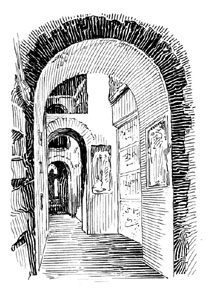The most successful scenario structure in the history of roleplaying games is the traditional dungeoncrawl. In fact, I believe that much of D&D’s success rests on the strength of the traditional dungeoncrawl as a scenario structure. (Notably, it is a structure which has proven extremely effective even when translated into other mediums and executed with completely different mechanics.)
First, for the player, it provides:
(1) A default goal. Specifically, “find all the treasure”, “kill all the monsters”, or some other variant of “clear the dungeon”. In other words, the structure inherently provides a reason for the player to engage the scenario.
(2) A default action. If a player is standing in a room and there’s nothing interesting to do in the room, then they should pick an exit and go to the next room.
Collectively, these mean that the player always has an answer to the question, “What do I do next?”
Second, for the GM, the dungeoncrawl is:
(1) Easy to prep. In fact, it’s virtually impossible for even a neophyte DM to screw up the design of a dungeoncrawl. What’s he going to do? Forget to draw an exit from the room?
(2) Easy to run. This extends beyond the macro-structure of the dungeoncrawl and begins to depend on the D&D ruleset itself, but, in general, any action proposed by the players within the dungeon will usually have a self-evident method of resolution. The dungeoncrawl also “firewalls” the adventure into discrete chunks (the individual rooms) which can generally be run as small, manageable packets.
Collectively, these mean that even first time DMs can reliably design and run a dungeoncrawl without leaving either (a) their players stymied or (b) themselves confused.
This is huge. Thanks to the dungeoncrawl, D&D can reliably create new DMs in a way that most other RPGs can’t and don’t.
But the dungeoncrawl also has a couple of other key features:
(1) It provides structure, but not a straitjacket. When the players ask themselves, “What do I do now?” the dungeoncrawl provides them with a default answer (“go through an exit”), but doesn’t prohibit them from creating all sorts of other answers for themselves: Fight the goblins. Investigate the arcane runes. Set up a fungal garden. Check for traps. Translate the hieroglyphics. Reverse engineer the construction of dwarven golems. Negotiate with the necromancer. And on and on and on. (It doesn’t even prevent you from leaving the structure entirely: The D&D rules include a multitude of options for bypassing the structure of the dungeon itself.)
(2) Flexibility within the form. The DM can put just about anything into the structure. Each dungeon room – each chunk of content delivered by the scenario structure – is a completely blank canvas.
Having this simple-to-understand, simple-to-design, and simple-to-use scenario structure makes D&D universally accessible in a way that, for example, Transhuman Space isn’t.
Next, let’s shift from the macro-level to the micro-level.













The dungeon also clears the playing field of confusing extra information (perhaps you’re coming to this – I’m reading through in sequence): there’s a lot you don’t have to define in a dungeon: social roles of the PCs, character histories and reputations, how they should treat repeated interactions… what’s left is a bald statement of a puzzle, much like a boardgame (and therefore a long ‘foregone conversation’ of eliminated options). What should I do can ONLY be, in the first instance, “explore the space” and “interact with those tokens that are presented by the DM” (or “suggest a token and see if the DM adds it”).
…OK, I should explain some implications of this obvious point: I think the clearing out of extraneous concerns is behind the bothersomeness of those infamous orc babies in Keep on the Borderlands. Monsters are a game token in the dungeon – for purposes of easy play they are stripped of content/meaning except as obstacles and maybe reward-dispensers. The orc babies introduce doubt about this structure, and therefore about the nature of the whole game. Because “baby” comes with its own set of signifiers which are at odds with “monster” it’s a perfect crowbar for forcing the tight structures of dungeoneering apart and letting out-of-game concerns in.
[…] С оригиналом статьи Вы можете ознакомиться здесь. […]
[…] mystery format of MoTW involves a great deal more preparation than Dungeon World or other games, where the dungeon structure can simplify preparation greatly. The mystery structure forces a certain amount of rail roading- the players only have agency within […]
Does this work for an entirely non-violent setting? A town, or a city, or a socially-focused situation?
Somewhat. Location-based scenarios have a lot of flexibility and can be used in a variety of capacities.
What you can easily lose, however, is the default goal. (I’ve also occasionally seen location-based scenarios where there’s also no clear default action, but that usually means it was a mistake to use the location-based structure in the first place.)
I delve into this a bit in Part 12 of this series (using appropriate and inappropriate scenario structures). For social stuff, you might want to check out Party Planning in particular.
[…] te recomiendo mucho leer la serie sobre estructuras de juego de The Alexandrian, sobre todo la parte sobre dungeoncrawls y hexcrawls (quien sabe si en futuro me animo a traducir esos artículos, que son una […]
Are you able to detail the various dungeoncrawl structures in the 1970s/early-1980s RPGs? I know you had a post quickly detailing these in OD&D; I can clearly see that Tunnels & Trolls has something similar, and arguably The Fantasy Trip, though I can’t see it for Runequest but maybe I’m missing it. Something like your hexcrawl or urbancrawl series. This would help some of us fine-tune our own procedures for dungeoncrawls.